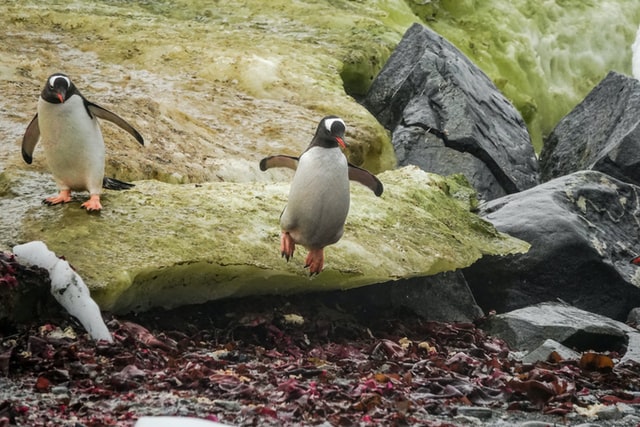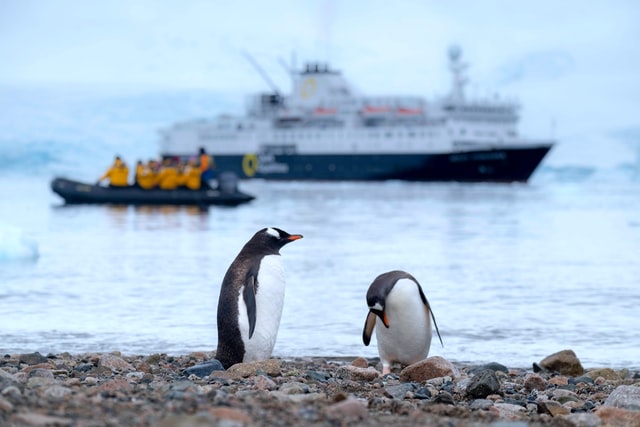Imagine looking out upon the Antarctic landscape. Chances are, you are envisioning sheets of white ice and snow, stretching as far as the eye can see. But the coastline of Antarctica is looking a bit different these days—and the changes are caused by rising temperatures.
The Antarctic coastline has always been slightly warmer than the rest of the continent. Scientists and the small groups of tourists who venture to the coast will see animal and plant life that could not survive in the interior. This environment is somewhat more hospitable than the regions closer to the South Pole, and if you happened to take a stroll along the coastline, it wouldn’t be surprising to see a few patches of green snow.

These patches are caused by algae growth, and the blooms have always been present in warmer areas of Antarctica, especially during the summer when temperatures are higher. They are more likely to bloom in areas where the temperatures hover just above freezing. They are also generally found in spots where penguins and other wildlife build their habitats, because their excrement is an ideal fertilizer for the algae. However, these blooms are spreading rapidly as average temperatures increase, and scientists say that this trend is not likely to reverse.
Researchers from the University of Cambridge and the British Antarctic Survey recently collaborated to create a thorough map of these green algae blooms that illustrates the extent of their spread across the continent. There are now well over one thousand different blooms, and they continue to grow in size. In fact, the blooms have now grown so large that they can actually be seen from space—and these researchers say that in the coming years, the blooms will cover more and more of the continent. Their presence will be especially noticeable on Antarctica’s peninsula, where average temperatures are increasing at a faster rate.
What is the significance of this development? The truth is that scientists aren’t quite sure yet, but the blooms may end up hastening the effects of climate change on the continent. Right now, these algae blooms actually act as a carbon sink. The algae draw down carbon dioxide from the atmosphere and absorb about 500 tons of carbon dioxide each year. At first, it sounds like this would be helpful—but scientists say that in the grand scheme of things, it’s basically insignificant.
The color of these blooms could counteract any positive effects that they would have. The blooms darken the snow wherever they are located, which affects how much light the snow reflects. For instance, researchers have determined that fresh, white snow reflects about 80% of the light that hits it. On the other hand, green snow only reflects about 45%. This means that it absorbs a much higher percentage of sunlight than white snow, causing more snow to melt wherever these blooms are located.
Aside from the strange visual spectacle, it may not seem like the presence of green snow is such a major development. After all, the existence of this green snow is nothing new in Antarctica. But the fact that these blooms are growing and expanding should give us pause. Sometimes, it can be hard to “see” the effects of climate change in such a striking way—but this is a clear indicator that something is very wrong.

Furthermore, these blooms are not just a result of climate change and rising temperatures—they could also worsen the effects. Climbing temperatures have contributed to their growth and spread. And in turn, these dark patches of algae will absorb even more sunlight, causing the snow beneath to melt even faster.
Although we may hear about how rising temperatures are affecting this distant continent, the impact may not feel like it matters in our daily lives. We may know that the melting ice sheets are contributing to sea levels rise around the world, and we may hear about indicators that the situation is worsening, like the growth of this algae. But it can be hard to grasp the true impact that even these small changes have in a place like Antarctica. Yes, it’s a massive place with a harsh climate—but it’s still very fragile.
Antarctica is home to unique wildlife and dramatic landscapes unlike anywhere else in the world. But in a place like Antarctica, rising temperatures can set off small changes that have massive ripple effects. Most of us will never see Antarctica—but we still have the chance to act and preserve the beauty of this continent.
Get more like this—Sign up for our daily inspirational newsletter for exclusive content!
__
Photo: Unsplash




